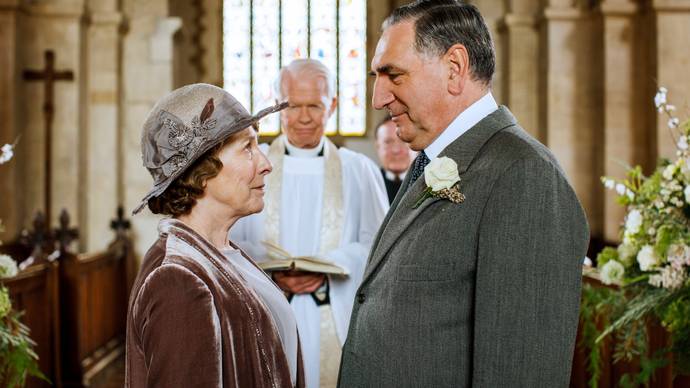It has already been noted that religion is almost nonexistent in the well-loved PBS series Downton Abbey (now in its final season). With the long-awaited nuptials of Mr. Carson and Mrs. Hughes, the question arises again of the invisible vicar, who appears only at weddings. The Toast begins with that observation, but moves on to discussing the language of the ceremony, from the Book of Common Prayer (pre-1920s revisions), and the presence faith on-screen and off:
The Book of Common Prayer, which had survived in much the same form since 1662, was at this very moment being revised in response to decades of pressure. A Royal Commission, created to undertake this work in 1906, finished its work in 1927. But the new book was rejected by the House of Commons, not once but twice, led by a group of MPs who believed that the new forms permitted undermined the church’s Reformation principles. The Church of England is an established, state church, and the monarch of Britain is its nominal head; according to a 1919 Act, any changes to the prayer book required parliamentary approval before they could receive the royal assent. Parliament’s rejection set up an awkward situation, resolved, somewhat tenuously, by the decision of the Church to assert its authority and allow bishops to use the new liturgy. In many books the old and the new forms were printed alongside one another.
Had Mr. Carson and Mrs. Hughes married just a few years later, then, Mrs. Hughes could have promised “to love and to cherish,” rather than “to obey,” her new partner, while Mr. Carson could have merely honored her with his body and shared his world goods. But, old-fashioned sentimentalists that they were, they probably would have stuck with the old form, just as Lord Peter Wimsey and Harriet Vane do in Dorothy L. Sayers’s novel Busman’s Honeymoon (1937)
Historian A.J.P. Taylor asserts that by this point in British history, religion had become more a matter of culture and morality than belief and spirituality, partly from a growing diversity of religious traditions and partly from the movement of social justice and care for the poor to secular entities:
Beginning in the 1870s, there was a shift from the severe personal convictions of evangelical mid-Victorians, to a more undogmatic, social Christianity that accepted multiple forms of belief even while it continued to regulate morality and behavior. By the 1880s, churchgoing had begun to decline.
and historian Callum Brown dates the “death of Christian Britain” to the 1960s.
Sunday’s Season 6, Episode 3 underscores the secularism of the British – sins and scandals, from tempers lost because of frayed nerves to political blackmail, are discussed and handled without any mention of religion or faith. Perhaps, says Mo Moulton, the episode is a reflection of today as much as it is of the 1920s:
Less than a year ago, in his Easter message, prime minister declared Britain to be “a Christian country,” insisting: “The church is not just a collection of beautiful old buildings. It is a living, active force doing great works across our country.” Downton, by contrast, gives us precisely a church that is a collection of beautiful old buildings: the rugged, ancient stone behind Mr. Carson was far more evocative than the minister, who said almost nothing even in the wedding scene. It is an accurate reflection of modern England, where 25% of the population said in 2011 that they had no religion at all and a further 5% identified as Muslim, making Islam the second-largest religious group in the country. Two-thirds of marriages are now civil ceremonies rather than religious ones. In 1925, however, things were quite different. Downton’s vicar is missing, but what’s really striking is that, as modern viewers, we’ve hardly missed him at all.

